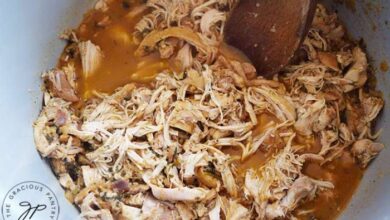
Instant Pot Tonkotsu Ramen Broth: A Guide to Creamy Perfection
Instant Pot tonkotsu ramen broth – it’s a phrase that evokes images of rich, creamy, and deeply flavorful broth, a hallmark of Japanese ramen culture. This traditional broth, known for its long simmering process, has been simplified thanks to the wonders of the Instant Pot.
Now, even home cooks can achieve that same depth of flavor without spending hours in the kitchen.
Tonkotsu broth, literally meaning “pork bone broth,” is the soul of this beloved ramen dish. It’s a testament to patience and precision, where pork bones are simmered for hours, extracting their essence and transforming into a silky, intensely flavorful broth.
The Instant Pot allows us to achieve this rich flavor in a fraction of the time, making it a convenient and delicious option for any ramen enthusiast.
Tonkotsu Ramen Broth

Tonkotsu ramen broth, a culinary masterpiece born in the heart of Fukuoka, Japan, is a testament to the power of slow cooking and meticulous preparation. Its origins can be traced back to the early 20th century, when pork bones were used to create a flavorful base for ramen, a popular street food in Japan.
Over time, the technique evolved, and tonkotsu broth, with its signature rich and creamy texture, became a beloved staple in Japanese cuisine.
The Ingredients and Their Roles
The key to the unparalleled richness and depth of flavor in tonkotsu broth lies in its carefully selected ingredients.
- Pork Bones:The foundation of tonkotsu broth is the pork bones, typically from the neck, spine, or feet. These bones are rich in collagen and gelatin, which break down during the long simmering process, creating the characteristic creamy texture.
- Water:Water is essential for extracting the flavors and nutrients from the bones. The quality of water can significantly impact the final broth.
- Salt:Salt plays a crucial role in balancing the flavors and enhancing the overall taste of the broth. It also helps to draw out the flavors from the bones.
- Soy Sauce:While not always used, soy sauce can add a savory depth and a hint of umami to the broth.
- Other Ingredients:Other ingredients, such as garlic, ginger, onions, or dried seaweed, can be added to enhance the flavor profile.
Traditional Methods for Preparing Tonkotsu Broth
Traditionally, tonkotsu broth is prepared using a slow and meticulous process. The bones are first cleaned and then simmered in water for an extended period, typically 12 hours or more. This slow cooking process allows the collagen and gelatin in the bones to break down, creating the creamy texture.
- Initial Simmering:The bones are simmered in water for several hours, initially on a high heat to bring the water to a boil. This initial simmering helps to extract the initial flavors from the bones.
- Lowering the Heat:After the initial simmering, the heat is lowered to a gentle simmer. The broth is then simmered for an extended period, often for 12 hours or more. This slow and gentle simmering allows the collagen and gelatin to break down, creating the creamy texture.
I love the rich, creamy flavor of homemade tonkotsu ramen broth, especially when it’s made in the Instant Pot. It’s so easy to make, and the results are always delicious. To balance out the richness of the broth, I like to pair it with a refreshing glass of orange carrot ginger juice.
The sweetness of the orange, the earthy flavor of the carrot, and the spicy kick of the ginger are the perfect complement to the savory broth. After all, a balanced meal is a happy meal, and tonkotsu ramen deserves a little brightness on the side!
- Skimming and Filtering:During the simmering process, any impurities or foam that rise to the surface are skimmed off. This helps to ensure a clear and clean broth. Once the broth has finished simmering, it is often filtered to remove any remaining bone fragments or impurities.
Instant Pot Method for Tonkotsu Broth
Making tonkotsu broth traditionally involves simmering pork bones for hours on end, often for days. This method produces an incredibly rich and flavorful broth but requires a significant time commitment. The Instant Pot offers a faster and more convenient way to achieve similar results.
Instant Pot Method vs. Traditional Methods
The Instant Pot method for tonkotsu broth offers several advantages over traditional methods. It significantly reduces the cooking time, making it a more practical option for busy cooks. However, there are also some disadvantages to consider.
- Advantages:
- Reduced cooking time:The Instant Pot’s pressure cooking capabilities allow you to achieve a rich and flavorful broth in a fraction of the time compared to traditional methods. You can typically achieve similar results in a few hours, as opposed to the days required for traditional simmering.
- Convenience:The Instant Pot’s hands-off nature is a significant advantage. Once you’ve assembled the ingredients, the Instant Pot takes care of the cooking process, freeing up your time for other tasks.
- Easier to control:The Instant Pot’s pressure and temperature controls offer a more consistent and controlled cooking environment, making it easier to achieve consistent results.
- Disadvantages:
- Flavor intensity:While the Instant Pot method can produce a delicious broth, it may not be as intense as a traditional broth simmered for a longer duration. The prolonged simmering process in traditional methods allows for a deeper extraction of flavors from the bones.
- Limited volume:The Instant Pot’s capacity may be limiting for larger batches of broth. If you need a large quantity of broth, you may need to use multiple Instant Pots or resort to traditional methods.
- Potential for pressure release issues:The Instant Pot’s pressure release mechanism may require some attention, especially when dealing with fatty ingredients like pork bones. It’s important to follow the manufacturer’s instructions carefully to ensure safe and proper pressure release.
Instant Pot Tonkotsu Broth Recipe
Here is a step-by-step recipe for making tonkotsu broth in an Instant Pot:
Ingredients:
- 2 pounds pork bones (a mix of marrow bones, knuckle bones, and feet is ideal)
- 1 large onion, quartered
- 2 carrots, roughly chopped
- 2 celery stalks, roughly chopped
- 4 cloves garlic, peeled
- 1 piece of ginger, about 1 inch, peeled and sliced
- 1 tablespoon salt
- 1 teaspoon black peppercorns
- 1/2 teaspoon ground white pepper
- 1/4 cup soy sauce
- Water, enough to cover the bones by about 2 inches
Instructions:
- Prepare the bones:Rinse the pork bones thoroughly under cold water. Place them in a large pot and cover with cold water. Bring the water to a boil, then drain the bones and discard the water. This step helps to remove any impurities from the bones and create a clearer broth.
- Assemble the ingredients:In the Instant Pot, combine the prepared pork bones, onion, carrots, celery, garlic, ginger, salt, black peppercorns, white pepper, and soy sauce.
- Add water:Add enough water to cover the bones by about 2 inches. Ensure that the water level is at least 1 inch below the “max” line of the Instant Pot.
- Pressure cook:Close the Instant Pot lid and set the valve to “sealing.” Cook on high pressure for 2 hours. After the cooking time is complete, allow the pressure to release naturally for 30 minutes. This helps to ensure that the bones have enough time to break down and release their flavor into the broth.
- Skim the fat:Carefully remove the lid of the Instant Pot. Use a ladle to skim off any excess fat that has risen to the surface. This will help to create a cleaner and lighter broth.
- Strain the broth:Line a large bowl or pot with cheesecloth or a fine-mesh strainer. Carefully pour the broth through the strainer, discarding the solids. The broth can be served immediately or stored in the refrigerator for later use.
Variations and Flavor Enhancements
While the classic tonkotsu broth is already incredibly flavorful, there’s a world of possibilities when it comes to customizing its taste. You can easily enhance the broth’s depth and complexity by incorporating different spices, vegetables, or other ingredients.
Adding Spices
Adding spices can significantly impact the flavor profile of your tonkotsu broth. Here are some popular options:* Ginger:A small piece of ginger, added during the simmering process, can impart a subtle warmth and a hint of citrusy aroma.
Garlic
A few cloves of garlic, added during the simmering process, can add a robust savory flavor and a pungent aroma.
Black Pepper
Adding black peppercorns during the simmering process adds a touch of heat and a slightly bitter note.
Star Anise
Adding a few star anise pods during the simmering process adds a subtle licorice flavor and aroma.
Cinnamon Sticks
Adding a cinnamon stick during the simmering process adds a warm, sweet, and slightly spicy flavor.
Chili Peppers
For a spicy kick, add a few chili peppers during the simmering process. The level of heat can be adjusted based on the type and quantity of chili peppers used.
I’ve been on a ramen kick lately, and nothing beats a rich, creamy tonkotsu broth. I’ve even been experimenting with making my own in the Instant Pot! It’s amazing how much flavor you can get from simmering pork bones for hours.
While I’m on the topic of delicious, slow-cooked meals, I recently tried chef johns zombie meatloaf and it was seriously good! The combination of flavors and textures was incredible, and it reminded me of how much I love experimenting with different cuisines.
Back to my ramen obsession, I’m planning on trying a few different toppings and noodle combinations to see what works best with my homemade tonkotsu broth. Stay tuned for the results!
Adding Vegetables
Adding vegetables to your tonkotsu broth can add sweetness, umami, and complexity. Here are some popular options:* Onions:Adding a few chopped onions during the simmering process can add sweetness and depth to the broth.
Carrots
Adding a few chopped carrots during the simmering process can add sweetness and a hint of earthiness to the broth.
Celery
Adding a few stalks of celery during the simmering process can add a subtle bitterness and a refreshing aroma.
The rich, creamy texture of my instant pot tonkotsu ramen broth is always a hit, but sometimes I crave something a little sweeter. That’s when I turn to my go-to recipe for cream cheese bars , a perfect balance of tangy and sweet.
But after a satisfying slice of those bars, I always find myself craving that savory, umami-packed tonkotsu broth again, reminding me that even the most delicious desserts can’t quite compare to the comfort of a perfect ramen bowl.
Mushrooms
Adding a few mushrooms during the simmering process can add umami and a savory flavor.
Seaweed
Adding a few pieces of seaweed during the simmering process can add a salty and umami flavor.
Adjusting Flavor Intensity
You can adjust the richness and flavor intensity of your tonkotsu broth by:* Simmering Time:The longer you simmer the bones, the richer and more flavorful the broth will become.
Bone Ratio
A higher ratio of bones to water will result in a richer and more concentrated broth.
Salt
Adding salt to the broth can enhance the flavor and balance the richness.
Fat Content
Skimming off some of the fat from the surface of the broth will reduce the richness and create a lighter broth.
Serving and Enjoying Tonkotsu Ramen

After all the hard work of making your rich, flavorful tonkotsu broth, it’s time to assemble your ramen masterpiece. This is where your creativity and preferences come into play. Tonkotsu ramen is a canvas for various toppings and garnishes, allowing you to customize your bowl to your liking.
Toppings and Garnishes
A variety of toppings and garnishes can enhance the flavor and texture of your tonkotsu ramen.
- Proteins:The most common protein in tonkotsu ramen is sliced pork belly (chashu), but you can also add other options like marinated eggs (ajitsuke tamago), chicken, or even tofu.
- Vegetables:Common vegetable additions include scallions (green onions), bamboo shoots (menma), spinach, or bean sprouts.
- Seaweed:Nori seaweed adds a salty, umami flavor and a pleasing textural contrast.
- Spices and Seasonings:A sprinkle of black pepper, chili flakes, or sesame seeds can add an extra kick of flavor.
- Other:You can also add a dollop of spicy chili oil or a spoonful of pickled ginger (gari) to add a tangy flavor.
Traditional Serving Order
Traditionally, tonkotsu ramen is served in a specific order to create a harmonious balance of flavors and textures.
- Broth:The rich, creamy tonkotsu broth is poured into the bowl first.
- Noodles:Ramen noodles are added next, typically cooked al dente for a firm bite.
- Toppings:The toppings are then arranged on top of the noodles, with the chashu often placed in the center.
- Garnishes:Finally, the garnishes are added as finishing touches, like a sprinkle of scallions or a drizzle of chili oil.
Achieving Flavor and Texture Balance
Creating a perfect bowl of tonkotsu ramen is about achieving a balance of flavors and textures. Here are some tips:
- Saltiness:The broth should be salty enough to balance the richness of the pork but not overly salty.
- Umami:The broth should have a deep, savory umami flavor from the long-simmered pork bones.
- Texture:The noodles should be cooked al dente for a firm bite, while the toppings should provide contrasting textures.
- Temperature:The ramen should be served hot, but not scalding.
Tips and Tricks for Success: Instant Pot Tonkotsu Ramen Broth
Mastering the art of Instant Pot tonkotsu ramen broth requires a few key considerations to ensure a rich, flavorful, and successful outcome. While the Instant Pot simplifies the process, certain techniques and considerations can elevate your broth to new heights.
This section will delve into common pitfalls, troubleshooting solutions, and storage tips to help you achieve the perfect tonkotsu broth every time.
Common Mistakes to Avoid
It’s essential to understand common mistakes that can affect the quality of your tonkotsu broth. By avoiding these pitfalls, you can ensure a successful and flavorful broth.
- Insufficient Bone-to-Water Ratio:A crucial element of tonkotsu broth is the ratio of bones to water. Using too little bone will result in a less flavorful and less rich broth. Aim for a ratio of at least 1:1 (bone to water).
- Not Browning the Bones:Browning the bones before simmering adds depth of flavor to the broth. This process caramelizes the natural sugars in the bones, contributing to a richer and more complex taste.
- Not Skimming the Broth:Skimming the foam that forms on the surface during the initial cooking phase is crucial. This foam contains impurities that can cloud the broth.
- Overcooking the Broth:While a long simmering time is essential for tonkotsu broth, overcooking can lead to a bitter taste. Follow the recommended cooking times and monitor the broth’s color and consistency.
- Not Using High-Quality Ingredients:The quality of your ingredients directly impacts the flavor of your broth. Use fresh, high-quality pork bones and avoid using bones that have been frozen multiple times.
Troubleshooting Cloudy Broth
Cloudy tonkotsu broth is a common concern, but it can be addressed.
- Skimming the Broth:As mentioned earlier, skimming the foam during the initial cooking phase helps remove impurities that can cloud the broth.
- Using a Fine-Mesh Strainer:After the broth has simmered, strain it through a fine-mesh strainer to remove any remaining particles that might be clouding it.
- Adding a Clarifying Agent:Some cooks use egg whites or other clarifying agents to remove impurities and achieve a crystal-clear broth. However, this is not essential and can alter the flavor slightly.
Troubleshooting Insufficient Richness, Instant pot tonkotsu ramen broth
If your tonkotsu broth lacks the desired richness, there are several ways to address this.
- Increase the Simmering Time:Simmering the broth for longer allows more collagen and gelatin to be extracted from the bones, resulting in a richer and more flavorful broth.
- Add More Bones:If you have the time and resources, adding more bones to the broth can enhance its richness.
- Use a Pressure Cooker:A pressure cooker can help extract more collagen and gelatin from the bones, resulting in a richer broth.
Storing and Reheating Leftover Tonkotsu Broth
Proper storage and reheating techniques are essential to preserve the quality and flavor of your tonkotsu broth.
- Storing:Allow the broth to cool completely before storing it in an airtight container in the refrigerator. It can be stored for up to 5 days.
- Reheating:Gently reheat the broth in a saucepan over low heat. Avoid boiling the broth, as this can cause it to become cloudy.






